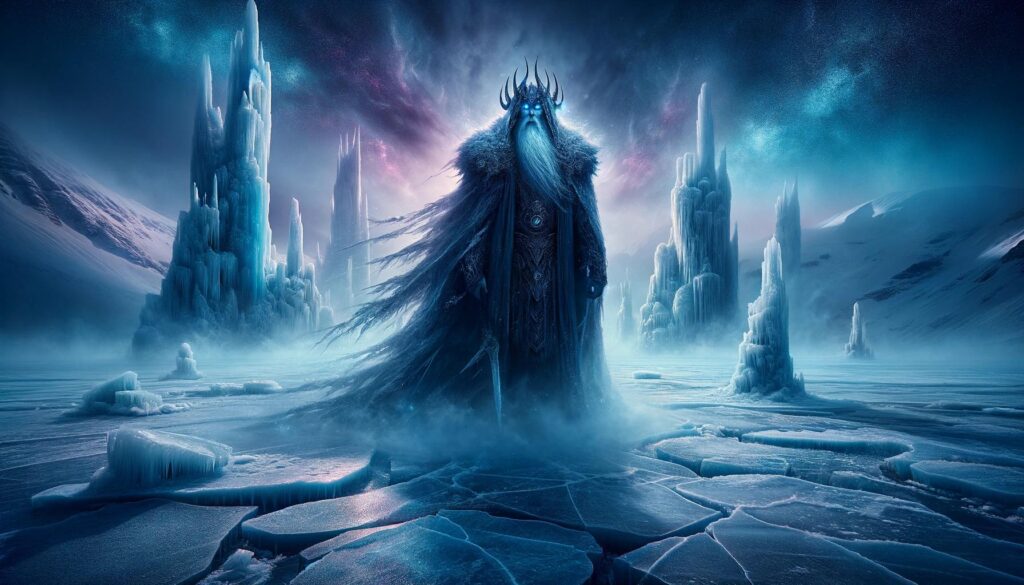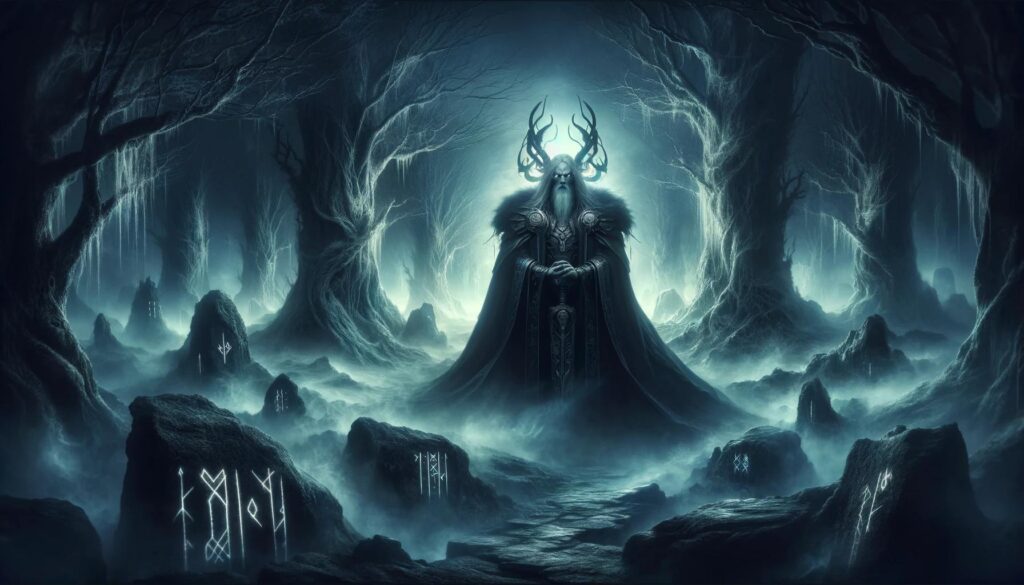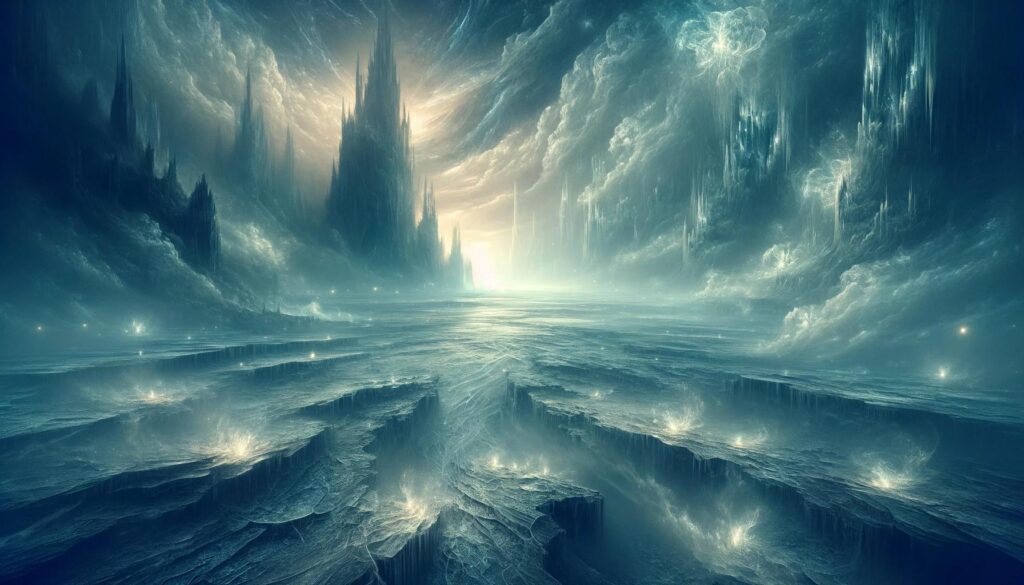Aesir Gods, Hodr, Norse Gods, Norse Mythology, Tales of the Gods
Norse Mythology God Of Darkness
Step into the mysterious world of Norse mythology and uncover the enigmatic Norse god of darkness. This powerful deity holds the key to ancient secrets and captivating tales in the realms of ice and shadows. Join us on a journey to explore the origins, role, powers, and symbolism of this intriguing figure in Norse mythology.
The Origins of Darkness in Norse Mythology
Uncover the captivating origins and mystical narrative surrounding Norse mythology darkness. Tracing its roots back to the dawn of time, the story of darkness weaves a rich tapestry of ancient lore and divine significance in the Norse pantheon.
According to Norse mythology, darkness emerged from the primal void known as Ginnungagap, the vast emptiness that existed before the creation of the world. From this primordial chaos, two worlds took form: Niflheim, the realm of ice and mist, and Muspelheim, the realm of fire and desolation.
The coming together of Niflheim and Muspelheim birthed Ymir, the primordial giant and the first being in Norse mythology. From Ymir’s body, the cosmos was fashioned, and the gods of Asgard, the realm of the Aesir, were brought into existence.
Creation of the Universe
- Odin, the Allfather and chief of the Norse gods, along with his brothers Vili and Ve, played a vital role in shaping the world as we know it.
- They slayed Ymir, and from his corpse, they created a vast expanse of land, sea, and sky.
- The world was divided into nine realms, each with its own inhabitants, creatures, and unique characteristics.
One of these realms was Niflheim, a frozen wasteland shrouded in eternal darkness. Within this icy realm, darkness found its dwelling place and the enigmatic deity that would come to embody its essence.
The origins of darkness are closely intertwined with the Norse god of darkness, whose name varies across different sources. Known as Nótt or Nött, Nótt was a primal force, a personification of the ever-present darkness that blankets the world during nighttime.
In some Norse myths, Nótt is described as the daughter of Narfi, the giant, while in others, she is born from the union of Annar and Trudgelmir. In either interpretation, Nótt possesses extraordinary powers that allow her to traverse the nine realms, enveloping the world in her eternal embrace each night.
The story of darkness in Norse mythology holds profound significance. It represents the cyclical nature of life and the eternal dance between light and shadow. Darkness, alongside its celestial counterpart, light, reflects the balance and harmony that exists within the Norse cosmology.
As we delve deeper into the intricacies of Norse mythology, we uncover the multifaceted role that the Norse god of darkness played within this ancient belief system. Exploring key tales, symbolism, and rituals associated with darkness, we gain a deeper appreciation for the enduring legacy of this enigmatic deity within Norse culture.
The Role of the Norse Mythology God of Darkness
Within the rich tapestry of Norse mythology, the Norse god of darkness has a significant role that permeates the divine hierarchy and the mortal realm. Popularly known as Hodr, this enigmatic deity wields immense power and influences the very fabric of existence.
Molding the Destiny of Other Gods
Hodr plays a crucial role in Norse mythology, shaping the fate of other gods. As the embodiment of darkness, this deity represents the balance between light and shadow, providing necessary contrast and depth to the pantheon. Through intricate relationships and alliances, the Norse god of darkness influences the unfolding narrative of Norse mythology.
Guiding Mortals through Darkness
Darkness holds great significance in Norse mythology as a metaphor for the unknown and transformation. The Norse god of darkness aids mortals in traversing these realms, leading them through trials and tribulations as they seek enlightenment or pursue their destinies. This deity acts as both a guide and a guardian for those venturing into the depths of the human experience.
Influencing the Forces of Nature
The Norse god Hodr exerts influence over the natural world, particularly in the darkening of days and the long winter nights. As the god of ice and darkness, this deity reigns over the colder months, shaping the seasonal shifts and demonstrating its power over nature’s cyclical rhythms.
- Assisting in the cycle of life and death in the natural world
- Affecting climate changes and the balance of power between light and darkness
- Impacting the growth and prosperity of crops and vegetation
Through these interwoven threads of divine influence, the Norse god of darkness plays a vital role in facilitating the harmony and balance of the Norse mythological realm.
Powers and Abilities of the Norse God of Ice and Darkness
The Realm of Darkness in Norse Mythology
The Norse God of Darkness and Other Deities
In the intricate pantheon of Norse mythology, the god Hodr, often associated with darkness, occupies a unique niche that intersects with the narratives and domains of other deities. Hodr’s story is deeply interwoven with themes of fate, destiny, and the inherent duality present within the Norse cosmological perspective, making his interactions with other gods particularly poignant and reflective of broader mythological themes.
Hodr’s most significant interaction is with his brother Baldr, the god of light and purity. Their tragic story highlights the stark contrast between light and darkness, with Hodr inadvertently causing Baldr’s death through Loki’s deceit. This event is not merely a familial tragedy but a cosmic one, illustrating the delicate balance and inevitable clash between contrasting forces, a recurring motif in Norse myths.
Loki, the trickster god, plays a pivotal role in Hodr’s narrative, manipulating him into killing Baldr. This act sets into motion events leading to Ragnarok, the end of the world. Through this, Norse mythology explores themes of causality, manipulation, and the intricate web of fate that binds the gods together, with Hodr and Loki’s actions serving as catalysts for the eventual dissolution of the cosmos.
Other deities also intersect with Hodr’s story, either directly or symbolically. For instance, Frigg, Baldr’s mother, embodies the maternal and protective aspects of divinity, her efforts to save Baldr from his prophesied death weaving her into the fabric of the narrative. Odin, the Allfather, represents wisdom and foresight, yet even he is powerless to alter the course set by fate, underscoring the omnipresent influence of destiny within Norse mythology.
Through Hodr’s interactions with these deities, Norse mythology delves into themes of darkness and light, manipulation, and fate, reflecting on the complex interplay between different forces and characters. Hodr’s story, therefore, is a lens through which the Norse envisioned the world’s inherent dualities and the inevitable march toward destiny.
Myths and Legends Associated with the Norse God of Darkness
In the rich tapestry of Norse mythology, Hodr stands out as a figure shrouded in darkness and tragedy. Often described as the Norse god of darkness, Hodr’s story is deeply intertwined with the concepts of fate and inevitability that pervade Norse legends. He is most famously known for his role in the death of his brother Baldr, the god of light and purity, an event that is both poignant and pivotal in the cosmic sagas of the Norse gods.

According to myth, Hodr was tricked by the cunning Loki into killing Baldr. The gods, aware of a prophecy foretelling Baldr’s death, had made everything in the world swear not to harm him, except for mistletoe, deemed too young to swear such an oath. Loki fashioned a dart from mistletoe and guided the blind Hodr’s hand to throw it at Baldr, leading to Baldr’s death. This act was not just fratricide but a cosmic imbalance, representing the encroachment of darkness over light, a theme central to Norse mythology’s reflection on the duality of existence.
The legends surrounding Hodr delve into themes of fate, manipulation, and the inevitable decline leading to Ragnarok, the end of the world. Hodr’s story, thus, is not just about the actions of gods but a reflection on the complexities of fate and the darkness that resides in the unknown. Through Hodr’s narrative, Norse mythology explores the depths of tragedy and the inexorable march toward destiny, making his legend a compelling study of the darker aspects of existence.
Representations of Darkness in Norse Art and Literature
Delve into the captivating world of Norse culture and uncover the artistic and literary representations of darkness. In Norse mythology, darkness holds a significant place, and its depiction in various mediums showcases the awe-inspiring imagery of the Norse god of darkness.
One of the most remarkable forms of Norse mythology art is found in intricate artwork. Paintings, sculptures, and carvings bring to life the enigmatic qualities of darkness, often portraying the Norse god of darkness with an aura of mystery and power. These artistic representations highlight the intricate details and symbolism attributed to darkness in Norse mythology.
Norse literature also vividly describes darkness. Poetic verses and sagas beautifully capture the essence of darkness, portraying it as an integral part of the Norse worldview. Through rich metaphors and evocative language, Norse literature delves into the depths of darkness, exploring its symbolic meanings and its influence on gods, heroes, and mortals.
The Imagery of Norse Mythology Darkness
The depictions of darkness in Norse art and literature go beyond its physical attributes. They highlight its symbolic and metaphorical meanings, offering deeper insights into the Norse pantheon and worldview.
- The darkness represents the primordial void from which all existence arises, symbolizing the potential for creation and transformation.
- It embodies life’s mysterious and unseen aspects, holding secrets and hidden knowledge.
- Darkness represents the power of the unseen forces that shape destinies, and the Norse god of darkness was portrayed as an influential figure in the cosmic order.
Darkness in Norse mythology becomes a powerful symbol through art and literature, evoking a sense of awe and fascination. The imagery of the Norse god of darkness reminds us of the complexities and mysteries of the Norse belief system.
Symbolism and Meaning of Darkness in Norse Mythology
Dive deep into the intriguing symbolism and profound meanings associated with darkness in Norse mythology. The concept of darkness holds significant metaphorical value, reflecting the complex worldview of the Norse people.
Metaphorical Interpretations of Darkness
Darkness in Norse mythology is often seen as a symbol of the unknown, representing the mysteries and untapped potential of the universe. It embodies the primordial chaos from which life emerges and the enigmatic forces that shape the world.
Furthermore, darkness serves as a metaphor for transformation and rebirth. It signifies the hidden aspects of one’s psyche and the journey of self-discovery. Just as the night sky conceals countless stars waiting to be discovered, darkness in Norse mythology conceals hidden truths and hidden paths to wisdom.
Significance in the Norse Worldview
In Norse mythology, darkness plays a vital role in the cyclical nature of existence. It represents the opposing forces to the light, highlighting the delicate balance between creation and destruction, order and chaos.
Darkness also symbolizes the harsh and unforgiving nature of the Norse cosmos. It is associated with harsh winters, freezing cold, and vast icy expanses of the realms. The metaphorical darkness serves as a reminder of the challenges and hardships that must be overcome to achieve greatness.
Exploring Symbolism Through Mythology
The symbolism of darkness is further explored through the myths and legends of Norse gods and heroes. It is often depicted in contrast to the light, representing the eternal struggle between good and evil, creation and destruction.
For example, the notorious wolf Fenrir, son of the trickster god Loki, is often associated with darkness and chaos. His battle with the god Tyr symbolizes the eternal struggle between order and disorder, with darkness personified as a formidable adversary.
- Darkness is a symbol of the formidable forces that challenge the gods and mortals alike
- The interplay between darkness and light is a metaphor for the cycles of life and death
- The symbolism of darkness in relation to the duality of human nature
- The metaphorical representation of darkness in the Norse concept of fate and destiny
By examining the myths and symbolism surrounding darkness in Norse mythology, we understand this elusive and powerful concept more deeply. It invites us to contemplate the complexities of existence, the interplay between opposing forces, and the transformative nature of darkness in our own lives.
Conclusion
Throughout this exploration of the Norse god of darkness in Norse mythology, we have unveiled this powerful deity’s enigmatic nature and enduring legacy. The origins of darkness in Norse mythology date back to ancient times, with its significance ingrained in the fabric of the Norse pantheon.
We have delved into the role and powers of the Norse god of darkness, discovering how this deity influences other gods and the mortal world. From controlling shadows to harnessing the power of ice, the god of darkness commands awe-inspiring abilities that set them apart.
The realm of darkness in Norse mythology offers a mesmerizing journey as we navigate through its mysterious landscapes inhabited by this formidable god. Furthermore, we have explored the interactions, alliances, and rivalries between the Norse god of darkness and other prominent deities, shedding light on the intricate dynamics of the Norse pantheon.
Unraveling captivating myths and legends has given us insights into the cunning schemes and epic battles associated with the Norse god of darkness. This deity continues to influence art, literature, and popular culture, captivating audiences with its enigmatic nature and profound symbolism.
In conclusion, the Norse god Hodr holds a significant place in Norse mythology, captivating audiences past and present. Their powers, legends and symbolic meaning continue to inspire and fascinate, cementing their enduring legacy as one of the most captivating deities in Norse mythology.


